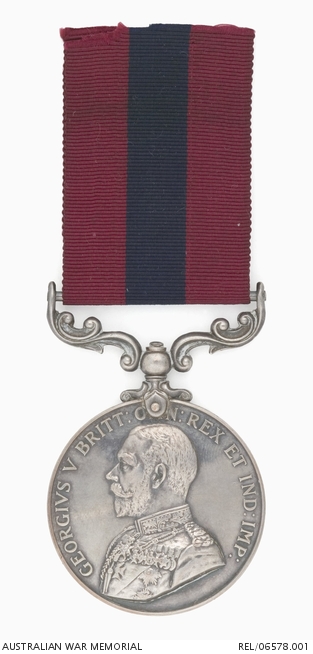| Place | Europe: France, Picardie, Somme, Bapaume Cambrai Area, Bullecourt |
|---|---|
| Accession Number | REL/06578.001 |
| Collection type | Heraldry |
| Object type | Award |
| Physical description | Silver |
| Maker |
Unknown |
| Place made | United Kingdom |
| Date made | c 1917 |
| Conflict |
First World War, 1914-1918 |
Distinguished Conduct Medal : Corporal J North, 3rd Light Trench Mortar Battery, AIF

Distinguished Conduct Medal (Geo V). Impressed around the edge with recipient's details.
Julian North, born Bunbury, Western Australia, was 24 years old and working as a painter when he enlisted in the AIF on 7 September 1914. Assigned to D Company, 11th Battalion under service number 931, he served on Gallipoli, where he was wounded on 11 July 1915, receiving a 'severe' gunshot wound to his left hand. He returned to his unit on Gallipoli on 26 October. In Egypt in 1916, after the evacuation, he was promoted to lance corporal.
North was again wounded, this time in his thigh, in France on 3 July 1916, but was able to return to duty three days later. It is likely this injury was sustained in 11th Battalion’s trench raid on German positions at "The Tadpole" (near Cordonnerie, between Fleurbaix and Aubers) on the night of 2/3 July, in the lead up to the Battle of Fromelles. His service record indicates he then reverted to the rank of private 'at his own request'. Two weeks later, on 19 July, he was attached to the newly-formed 3rd Australian Light Trench Mortar Battery where he was placed in charge of a Stokes Mortar, just prior to their involvement in the Pozieres battle, where they closely followed the advance of the infantry. The 3rd Light Trench Mortar Battery provided close and specific support for the 9th,10th,11th,12th Infantry Battalions of the 3rd Infantry Brigade for the rest of the war.
In January 1917, when the battery were at Dernancourt, North was promoted to corporal. At Bullecourt in May 1917, he was awarded the Distinguished Conduct Medal for his actions during a German counter-attack. The recommendation for his award reads: "At Bullecourt, France 6th May 1917, for conspicuous gallantry and devotion to duty. Early on the morning of Sunday 6 May the enemy made a strong counter-attack on the Brigade Sector in the Hindenburg Line, advancing rapidly along O.G.1. [Old German Trench] North, who was in charge of a Stokes Mortar in O.G.1., brought his Gun into action and with great courage, coolness and determination fought his Gun until the enemy reached within 10 yards of him. Assisted by part of his crew he then bombed the enemy and at the same time ordered the remainder of the crew to take the Gun back to reserve.
By his courage and presence of mind both the crew and gun were saved. The example set by this N.C.O. had an excellent effect on the men of his crew."
The unit's war diary notes that the Germans attacked at dawn and had been repulsed by 8 am; "after firing all ammunition available, guns were withdrawn." Charles Bean adds that the German attack were supported by flame throwers, machine gunners and bombers (see Official History of Australia in the War of 1914-19, Vol IV, pp 513 to 515).
Between March and April 1918 Corporal North was detached for duty at the 3rd Australian Infantry Brigade School in France as an instructor. He rejoined his mortar unit in early April and was wounded for the third time on 3 July at Strazeele, suffering a mild gunshot wound to his hip, but was back in action on the same day. After being promoted to temporary sergeant on 20 September, Julian North returned to Australia in October 1918 as part of the Anzac Draft 1914 scheme. He was discharged from the AIF on 17 February 1919.
Related information
Conflicts
Events
Subjects
People
Related Objects
- North, Julian (Sergeant, b.1892 - d.1955)
- 1914-15 Star : Private J North, 11th Battalion, AIF
- British War Medal 1914-20 : Sergeant J North, 11 Battalion, AIF
- Victory Medal : Sergeant J North, 11 Battalion, AIF
- Group portrait of the Light Trench Mortar Battery of the 1st Division. Identified from left to ...